Calais
Published February 15th, 2021 - written by: Thomas Müller
Thomas Müller writes for the blog JungleOfCalais, published in February 2021
Calais – Britain's externalised border
For more than two decades, the northern French port and border town of Calais has been the scene of unregistered migration from mainland Europe to Britain.[1] While in the 1990s it was often people from the former communist dictatorships in Eastern Europe or from the war zones in the Balkans who were stranded in Calais, thereafter it was mainly displaced people from Afghanistan and neighbouring Pakistan, from the East African countries of Sudan, Ethiopia and Eritrea, as well as from Iran and Iraq or Kurdistan. People from these regions have made up the largest part of the temporary migrant population in northern France since the 2000s, although the number and share of the individual groups of origin fluctuate. Until the mid-2010s, these were often people who had recently arrived in Europe via the Mediterranean or the Balkan route. After this time however, the number of displaced people in Calais whose recognition procedure in another EU country – often Germany – had failed, and for whom the UK had not been a primary migration destination until then, increased.

Not all of these people live in Calais itself, as other places are also used as a starting point for the journey to the UK. These are, in particular, the small town of Grande-Synthe near the port facilities of Dunkirk, other French, Belgian, Dutch and Spanish ports, places within reach of the highways leading there, and the capitals of Paris and Brussels. Calais is thus the centre of an extensive migration area between (at times) the Spanish ports of Bilbao and Santander far to the Southwest, Luxembourg to the Southeast, the Belgian-German border at Aachen to the East, and the Hook of Holland to the North.
Calais is also within the historical core area of European integration where the border was as strongly securitised as the southern and south-eastern external borders of the EU. One consequence of this border regime is the fortress-like expansion of the transport routes to the UK with fences, walls, surveillance technologies, patrols, obstacles to movement and glacises, which began at the turn of the millennium. A local Calais newspaper estimates the length of the fences added since 2015 at 65 kilometres alone. The impact of this border regime: from 1999 to 2020, 299 deaths have been documented[2] – more than in any other border area inside the EU. In addition, the expansion of border facilities has made viable migration paths scarcer, creating a lucrative market for professional smugglers – called mafias. Until Brexit, the concept of an internal external border therefore aptly described this situation. Since the UK's exit from the EU, the English Channel has become an EU external border in the literal sense – an external border, however, where only exits are prevented.
In the same way that the EU externalises its external border into its surrounding geographical area, for example into North Africa, using the sea as a natural barrier, the UK has also externalised the fight against migration into French territory, with the English Channel acting as a kind of Mediterranean in miniature. Here as there, this does not bring about an end to migration, but forces migrants to stay near the border for longer periods of time and to search for migration paths that are still viable, even if they are risky or costly. These people first set up makeshift camps in Calais in the late 1990s. The perpetuation of such makeshift camps began a story that was to gain international attention as the Jungle of Calais.
The Big Jungle of Calais
The name Jungle originated in the late 2000s. It was derived from what was then a large camp in a forest – Pashtun: djangal/dzhangal – and is still present in the names of many camps today, although it is more common for larger, more complex or multi-ethnic settlements to be called this.

While the early Jungles were home to a few hundred, sometimes around a thousand people, a particular camp created through state intervention quickly grew in spring 2015 into a settlement of tents, huts and containers with several thousand residents, in which over 10,000 people would live a year and a half later, many of them homeless in France during an asylum procedure or seeking access to the French asylum system. While the authorities named the settlement La Lande after the wasteland and landfill site on which it was located, it became the epitome of the Jungle of Calais in the public eye; its retrospective designation as the Big Jungle also reflects this dynamic.[3]
The Big Jungle consisted partly of state-installed facilities: a day centre with access to meals, electricity and sanitation (but no shelters), an area for housing women and underage children, and a container camp for people seeking access to the French asylum system. The majority of the residents, however, lived in an "informal" but state "tolerated" area, for which the authorities provided a primitive infrastructure of water points, washing places, portable toilets, rubbish containers and street lamps and tried to establish a kind of indirect management. In this double structure of camp and camp, the Big Jungle resembled the Moria camp before its fire in September 2020.
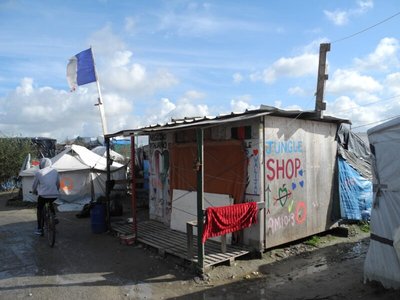
Providing for the residents was therefore largely in the hands of the asylum seekers themselves or was done by local civil society organisations, professional NGOs and a multitude of spontaneously emerging initiatives. Informal businesses, infrastructures and institutions developed in the Big Jungle, including around 70 restaurants, shops, cafés and other commercial enterprises, several mosques and churches, as well as several informal schools, youth, leisure and cultural facilities, legal counselling, medical and psychological contact points and a protected neighbourhood for women and families with children. Such differentiation had already begun in some preceding jungles and squats, but never in such complexity and densification. This development can be understood as a process of urbanisation, as the beginning of the transformation of the Big Jungle into a migrant city in the middle of Europe. This understanding of the Jungle as a city was analysed, for example, by the migration researcher Michel Agier and the architect Cyrille Hanappe, placed in the global context of informal urbanisation and defended as an alternative to hermetic camp structures.[4]
The Big Jungle was also an eminently political place. Its very location next to the ferry port's feeder highway meant that most ferry passengers saw it fleetingly at the height of the "European migration crisis". Countless journalists – including from the aggressive British tabloid press – visited the Jungle, but were increasingly perceived as a burden by its inhabitants: We are not animals, and the Jungle is not a zoo! At the same time, the numerous political, educational, religious, cultural, artistic, media and academic initiatives integrated the Jungle into their respective networks, making it a point of reference and a laboratory for civil society action. The activist and artist Zimako Mel Jones, after building an informal school, suggested programmatically that the Jungle should be renamed "Forum" because of the colonial and racist connotations of this term, since it had become such a public place.
None of this relativises the fact that living conditions in the Jungle were precarious at all times. There were permanent shortages, economic and sexualised exploitative conditions, crime and even homicide. Collective acts of violence also occurred several times, such as when a large Sudanese residential area was burned down by some Afghan residents in May 2016 without the French police intervening. These problems are also reflected in a series of empirical studies by the British initiative Refugee Rights Europe, which asked, among other things, about experiences of violence and fears.[5] However, these surveys show that people primarily feared the police and had mostly experienced police violence themselves. Human rights violations by the police, especially the omnipresent Compagnies Républicaines de Sécurité (CRS), have been and continue to be documented and denounced by activists[6], international NGOs[7] and state agencies such as the Défenseur des droits[8], but continue unabated.
This review of the Big Jungle is essential to understanding the situation after its eviction in October 2016: While the authorities had deliberately created this place in order to remove the displaced people from the public space of the city, to dissolve their scattered places of living and instead concentrate them in a common place seven kilometres from the centre, they had obviously not anticipated the attraction and dynamics that the Big Jungle would unleash. Its eviction became a large-scale logistical operation, during which most of the residents were taken to special reception and orientation centres (Centre d'accueil et d'orientation; CAO) that had been set up throughout France, with the exception of the Calais area. Some of the unaccompanied minors, who had relatives in the UK and had to meet additional age and nationality criteria, were allowed to enter the UK legally, but the UK government quickly ended this possibility.
Since the eviction, the police have focused on combating so-called "fixation points" (points de fixation). This term refers to sites of emerging camps that are evicted early and repeatedly, often combined with the removal or destruction of tents, tarpaulins and other personal property, which in turn creates ongoing stress, insecurity and sleep deprivation for the people affected. On a legal level, early and repeated evictions deny affected people the opportunity to seek provisional toleration of their place of residence in court. The overarching goal of state and municipal actors was and is to prevent something like the Big Jungle from ever happening again.
Calais as a "hostile environment"
In 2013, the British Home Secretary and later Prime Minister Theresa May coined the term "hostile environment", and asserted this had to be created for "illegal migrants".[9] The French authorities' action against the "fixation points" can be understood as the implementation of this demand on French soil.
As expected, the destruction of the Big Jungle did not end migration in Calais. In the winter after the eviction, several hundred of the people returning to Calais or newly arriving lived without any shelter under the bridges of the city centre, under balconies, in parks and even in the roadside greenery. As part of their tactics against the "fixation points", the police did not tolerate the use of tents and protective tarpaulins, so people sometimes had to carry their sleeping bags and thermal sheets with them. In the same winter of 2017, the conservative mayor Natacha Bouchart actively obstructed the aid efforts of humanitarian organisations. The grotesque attempt to prevent the provision of showers by Secours Catholique, the French Caritas, by having the mayor block the entrance to their social centre with a dumpster, became nationally known.

In the following years, the number of refugees initially increased to a range between 400 and 700 people in Calais and a somewhat smaller number in Grande-Synthe and in Brussels. Very slowly, tiny camps and meeting points were formed, which were regularly approached by civil society organisations to distribute meals and relief supplies and to provide access to medical and legal assistance. Attempts by the authorities to stop this, too, resulted in a legal battle, at the end of which the Council of State, as the highest French court, confirmed the inhumanity of living conditions in Calais and obliged the authorities to provide shelter and basic humanitarian care. Against this background, the prefecture contracted the aid organisation La Vie Active, which had already operated the day centre and container camp in the Big Jungle, to provide drinking water, meals and sanitary facilities. It also provided voluntary transfers to special shelters (Centres d'Accueil et d'Examen des Situations; CAES), which, like the CAOs, were located outside Calais. As a variant of this accommodation, a special type of supposedly humanitarian evictions developed: In these so-called mise à l'abri operations, the residents of the camps are usually stripped of their tents and forcibly taken to a CAES, from which they usually return immediately. After their tents are taken away, they find themselves in an even more precarious situation.
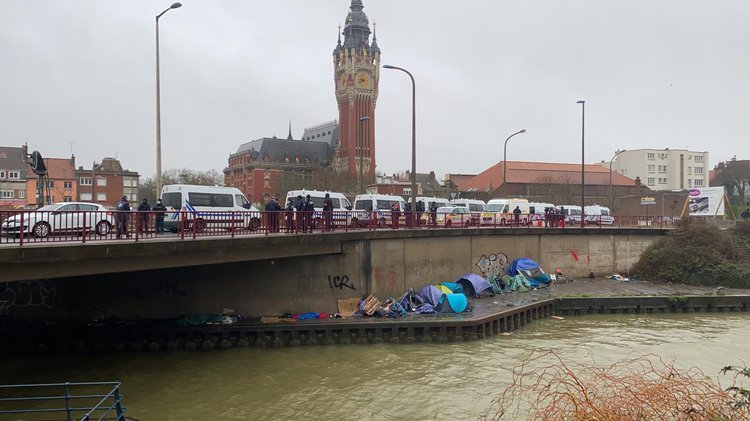
By 2018, a common meeting point with a few small camps had emerged in the Zone des Dunes industrial area. This industrial area had been the site of much of Calais' migratory activity since the 1990s, as it was within easy reach of the port and included numerous trucking infrastructures, most of which were later closed; the Big Jungle had also been located right next to Zone des Dunes. When the newly created meeting place was cleared in March 2019, the area was cordoned off with a massive fence. As it would later turn out, this was the beginning of fencing off all settleable areas of the Zone des Dunes and the adjacent small forests by 2020.
In the meantime, La Vie Active maintained a drop-in centre with access to drinking water, meals and sanitary facilities on Rue des Huttes, a street at the other end of the Zone des Dunes not far from the former Big Jungle. Around this drop-in centre, displaced people of different nationalities now set up several new camps, occupying a considerable area in 2019/20, commonly referred to as the New Jungle. The number of migrants in Calais rose to 1,000 or more people, most of whom lived in the New Jungle. In addition, there were a number of smaller camps, including one on a brownfield site at Calais Hospital.
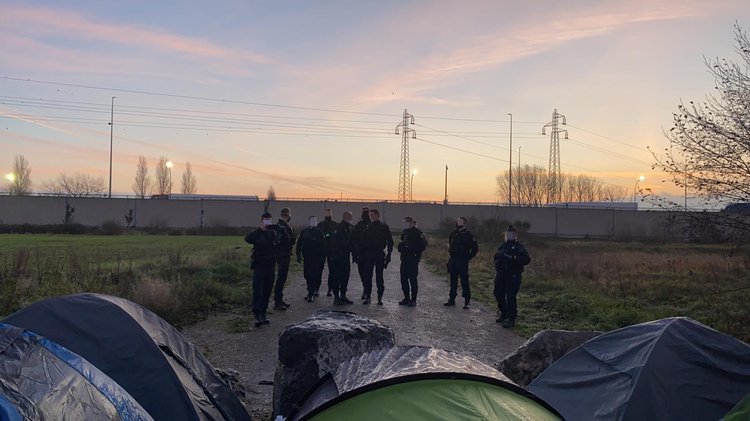
The police action against the "fixation points" did not end there, but it changed its character, because instead of a newly emerging camp, the Jungle and the other camps were now also cleared at intervals of mostly 48 hours: In these grotesque operations, officers combed the area, from which the residents then had to move their tents and possessions a few metres or move to safety on the next street – thus, in a sense, clearing themselves – to return again after the end of the operation, until the same procedure would be repeated in two days. Continuously practised, this prevented the emergence of more permanent shelters and infrastructures, as had existed in the Big Jungle, maintained the precariousness of living conditions and established a routine of recurrent humiliation. In 2019 and 2020, Human Rights Observers recorded 961 and 973 evictions in Calais, respectively, most of which took place in this way. [10]
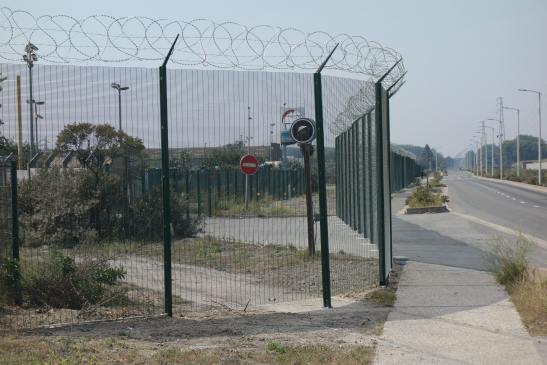
On 10 and 11 July 2020, the French Minister of the Interior, Gérald Darmanin, had the New Jungle cleared, the site of which has now also been fenced off. The eviction was one of the conservative minister's symbolic first acts in office and set the stage for a meeting with his British counterpart Priti Patel on 12 July in Calais, which was to focus on combating clandestine boat passages. Some of the displaced people settled on the derelict site at the hospital, but the Hospital Jungle was also massively cleared on 29 September 2020. After that, the site of Fort Nieulay at the other end of Calais came into the focus of the authorities. In the run-up to Brexit, migrants from there tried to find a hiding place in one of the lorries that jammed up there particularly frequently.
Darmanin's tightening included a ban on food distribution in certain parts of Calais, unless they were carried out on behalf of the state. La Vie Active thus effectively became the only organisation allowed to provide aid in all parts of Calais. The ban was initially imposed for a limited period on 11 September 2020 and has since been regularly extended and geographically expanded. The granting or non-granting of humanitarian aid now increasingly served to put pressure on the approximately 700 displaced people living in Calais at the time and to regulate their presence in the various parts of the city.
The Corona pandemic has hardly changed the situation of the displaced people.[11] During the two confinements (curfews) in the course of the first and second wave, camp residents were informed by the authorities about hygiene rules, social distancing and curfew restrictions, but the daily evictions, destruction of tents and confiscation of personal property continued unchanged. Massive police violence was also documented during these phases, including the severe head injury of an Eritrean man by a rubber bullet on 11 November 2020.[12] At the same time, the authorities used the existing restrictions to hinder the documentation of their operations.
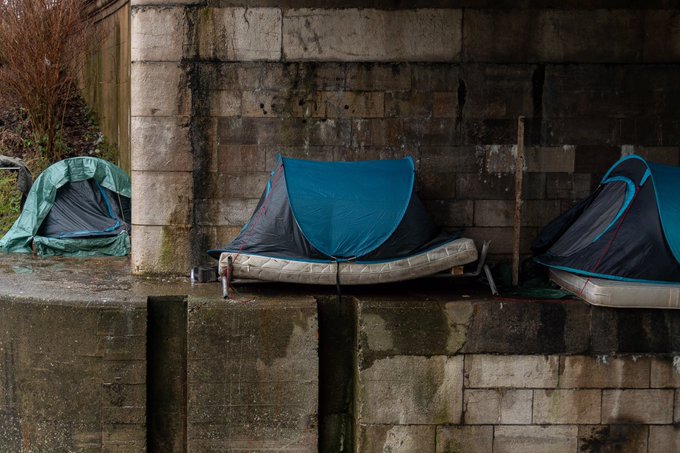
It quickly became clear that the authorities in Calais were not prepared for the pandemic, that they did not have adequate accommodation and that civil society organisations were left to fend for themselves. An evacuation of the first residents of the Jungle was therefore only scheduled for 31 March, but did not take place after five cases of infection became known. This was followed in April by voluntary and temporary accommodation in specially created shelters outside Calais with a capacity of 450 places, from which some returned after a short time. Meanwhile, the confinement resulted in a partial breakdown in the provision of meals and briefly led to starvation situations. The civil society organisations now switched to distributing firewood and food for self-cooking, while La Vie Active, acting on behalf of the state, distributed packed lunches instead of meals. From Grande-Synthe, where the authorities handled the situation similarly, there are reports of catastrophic health situations at the beginning of the pandemic. During the second confinement in Autumn, the prefecture again set up separate shelters at the beginning of November 2020, in addition to search trips for obviously ill people. By the end of 2020, there were no more supply bottlenecks as there were in the Spring.
The establishment of the Channel route
In the past twenty years, there have been repeated attempts to cross the English Channel in small boats or even by swimming. The cinema film Welcome from 2009 addressed this with the fictional example of a young man who, after intensive training, attempts to swim and dies.
Nevertheless, until 2018, freight transport was the main migration route to the UK. In this approach, displaced people tried individually or in small groups to find a hiding place in, on or under a lorry or a train. Frequently, transport infrastructures such as rest areas and petrol stations served as starting points for this. With the increasing securitisation of transport routes, these facilities were closed, relocated or fenced off, which made them a scarce commodity for displaced people. On the one hand, groups and commercial smugglers now appropriated access to such places and demanded quid pro quos for access, and on the other hand, the action along the motorways shifted far inland, for example to the Brussels-Oostende motorway, the Liège area and Luxembourg. A variation of this migration technique uses traffic congestion at the entrances to the Channel Tunnel and ports, or creates it through obstacles or running onto the roadway itself. One of the most dangerous techniques was jumping from bridges onto moving trucks. Time and again, serious injuries and fatalities have occurred in these contexts on the roadway, on railway facilities and in cargo holds; among the documented fatalities, these are the most common causes of death.
Such techniques also mean making many futile and risky attempts over long periods of time, and sometimes having to pay money of several hundred euros even for these attempts. An alternative is commercial smuggling, which is carried out with the help of cooperating truck drivers, for example, and is usually quoted at around 5,000 euros.
In October 2018, a new development began that was to develop a similar dynamic in the following years as the Big Jungle had in the years up to October 2016: the increase in boat passages across the Channel. At first, mainly Iranian exiles – and especially those who had entered by air and land via Serbia and were therefore not already traumatised by a boat passage – crossed the English Channel in this way. They primarily used motorised dinghies, some of which had been legally acquired and some of which had been stolen. The passages were prepared partly by commercial smugglers for a sum of around 3,000 to 5,000 euros, but also partly self-organised in small groups. The French authorities soon reacted by making it more difficult to sell boats and nautical paraphernalia such as life jackets and calling on the public to report possible Channel crossing preparations.
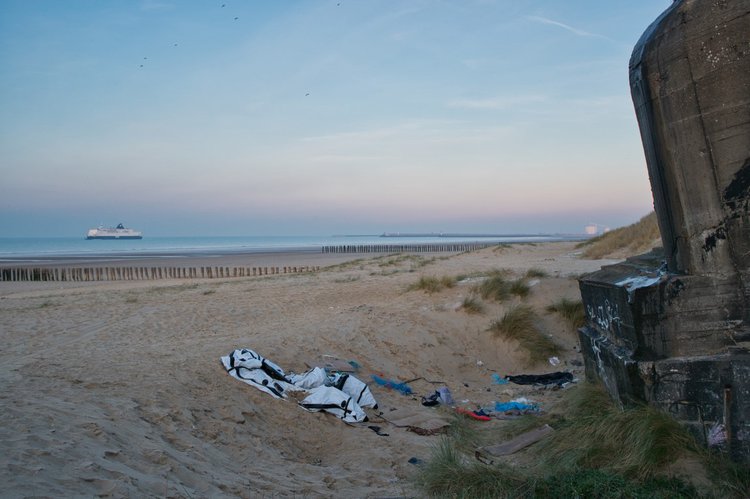
The exact number of boat passengers is reported differently in various official and media sources. What is certain is that around 300 people reached the UK in boats in 2018, around 90 per cent of them in the months of October to December, with an initial peak during the Christmas holidays. In this situation, a populist campaign by British tabloid media and politicians began, portraying the arrival of these comparatively few displaced people as an invasion, appealing to the powerful narrative of British nationalism. The then Home Secretary, Sajid Javid, deemed the boat passages a "major incident" and ordered two Border Force patrol boats to be redirected from the Mediterranean to the Channel, while the Ministry of Defence deployed a warship to cover the time until their arrival.[13]
On 24 January 2019, Javid and his French counterpart Christophe Castaner signed a Joint Action Plan [...] on combating illegal migration involving small boats in the English Channel. The plan regulated cooperation between the two countries in search and rescue operations and in aerial surveillance. The UK provided France with funds for surveillance equipment and patrols at sea, on the beaches and in the coastal areas. The plan also aimed at the rapid deportation of as many boat migrants as possible to France. The idea of deterring future boat passengers through immediate deportation has pervaded British policy ever since and was to be radicalised by Javid's successor, Priti Patel, into a demand for pushbacks at sea.
In the course of 2019, boat passages prevailed as the most effective migration path: In total, between 1,800 and 2,000 people crossed the Channel, depending on the source, which was many times higher than the previous year. At the beginning of this development, there was also a singular major event: on 2 March 2019, between 100 and 200 residents of the Jungle stormed onto the grounds of the Calais ferry port and partly got onto a ferry. The event was not documented by journalists or local initiatives. While the authorities summarily blamed it on smugglers, a Jungle activist involved described it to us as a political protest action, in the course of which people spontaneously took the opportunity to get onto the ferry, which happened to be open. In the process, some people would have been in mortal danger if they fell into the churning water, while some would have made it onto the island, contrary to what the authorities said. This event is relevant above all because the border regime was broken here – albeit selectively – in a collective action at one of the most heavily fortified and monitored places ever.
During 2020, between 8,400 and 8,700 people reached the UK in small boats, bringing the total since 2018 to just under 11,000 people. Although this represents a comparatively small proportion of immigration to the UK (where just under 45,000 asylum claims were made in 2020), it has undermined the externalised border on an unprecedented scale. Almost monthly, the British media reported new monthly and daily records, with a maximum of almost 2,000 successful passages in September, or 416 people in 28 boats on 2 September. At the same time, with the exception of December, the number of monthly passages increased so that each month was higher than the respective month before and higher than the same month the previous year. While in the beginning, the boat passages were mainly made up of Iranian migrants, soon they were made up of people from very different countries of origin, including Yemen and various West African states.
The most important reason for the dynamization of the Channel route was very likely the exceptionally high chance of success at comparatively low risk. All available data on the ratio of successful and prevented passages show: More than half of the crossings, possibly as many as 70 per cent, are successful, and the chance of obtaining a right to remain in the UK through subsequent asylum proceedings is also good, notwithstanding the threats of deportation. At the same time, the probability of dying during a boat passage is lower than, for example, in the Mediterranean or in attempts to reach the UK on lorries or trains. Other reasons cited for the increase in boat passages are the reduction in freight traffic during the first wave of the Corona pandemic in Spring 2020 and favourable weather conditions. The crossings are also facilitated by the topography of the French Channel coast, which favours concealed casting off in an area of about 150 kilometres between Boulogne-sur-Mer and Dunkirk, as this can only be monitored with a high level of personnel and technical efforts. The comparatively low number of fatalities is also thanks to reliably working coast guards. At times, local newspapers in the Calais area reported weekly on the rescue of migrants who were often in mortal danger shortly after setting sail.
Nevertheless, boat passages carry high risks due to the dense shipping traffic in the English Channel, strong currents, frequent fog and low water temperatures. This is especially true when people resort to unsuitable boats, children's inflatable boats, self-constructions from surfboards or attempts to swim.
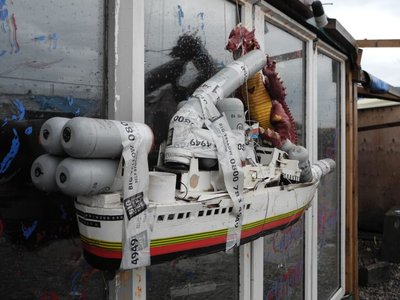
Thirteen deaths[14] as a result of attempting to cross the Channel were reported between 2018 and 2020: On 9 August 2019, Iranian PhD student Mitra Mahrad fell into the sea during a salvage operation and drowned. On 18 August 2019, the body of Niknam Massoud from Iraq was found at Belgium's Thorntonback offshore wind farm, having attempted to swim the Channel using a flotation device constructed from empty plastic bottles. On 14 October 2019, the bodies of Hussein Mufaq Hussein and Soran Jamal Jalal, who had crashed in a rubber dinghy, were discovered on the beach of Le Touquet (Pas-de-Calais). On 5 September 2020, the newborn child Aleksandra H. died of perinatal anoxia after her pregnant mother, as she wrote in an open letter in 2021, had been arrested before the boat set off, received no medical help for hours despite requests to the police to that effect. While the hospital that later treated her induced an emergency birth, they were unable to save the child. On 19 August 2020, Abdulfatah Hamdallah was found drowned at Sangatte beach near Calais. Together with a friend who survived, he had tried to cross the canal in a child's inflatable boat using shovels as oars. On 18 October 2020, the body of Behzad Bagheri-Parvin from Iran, who had wanted to cross the Channelalone, was also found in Sangatte. The biggest accident so far occured on 27 October 2020 off Loon-Plage: seven Iraqi Kurds from the Grande-Synthe camps near Dunkirk drowned there. Among them was the family of five of Rasul Iran Nezhad and Shiva Mohammad Panahi with their children Anita (9 years), Armin (6 years) and Artin (15 months). These deaths were and are regularly instrumentalised by the British government to call for a "closure" of the Channel route and to legitimise the existing border policy.
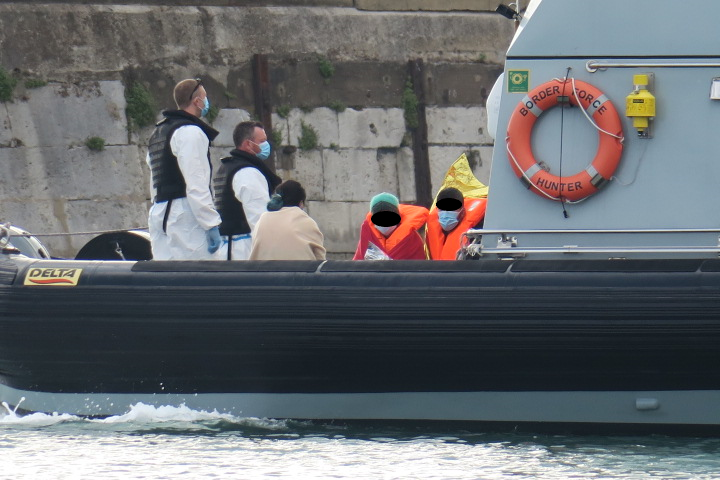
In the summer of 2020, Channel migrants became a dominant issue in British domestic politics. The right-wing populist politician Nigel Farage cruised the Channel to document the alleged invasion of the island. Small groups, some with far-right ideological views, patrolled the English Channel coast, while British lawyers who successfully intervened against deportations of Channel migrants became targets of media and political campaigns as "activist lawyers", culminating in a knife attack on a lawyer on 7 September. At the same time, however, the boats became a point of reference for solidarity politics, which is expressed in the initiatives Watch the Channel and Channel Rescue. The latter aims to provide a private ship in order to document the actions of the state authorities in the Channel, especially pushbacks, and to be able to provide immediate help if necessary.
At the beginning of October 2020, several British media reported on the considerations of the British Home Office to carry out pushbacks at sea and to prevent boats from entering British waters by means of a floating barrier in the middle of the English Channel or even by using a wave machine. Successful boat passengers were to be interned in remote locations in these thought experiments, modelled on the Australian "Pacific solution"; islands in the South Atlantic or former drilling platforms were mentioned. Such scenarios highlighted radicalisation processes in British migration policy, albeit in an extremely distorted form: a "border regime on steroids", as journalist Tobias Müller characterized it.
Meanwhile, the British government negotiated further bilateral measures with France. According to the UK, it exerted considerable pressure to secure France's necessary consent to pushbacks at sea, but failed, among other things, because of French doubts about their legality. When Patel and Darmanin signed another agreement in Calais on 12 July 2020 – following the evacuation of the Jungle – this agreement only regulated the "creation of a Franco-British intelligence unit on the issue of migration". This complemented the already existing structures of border police cooperation and included the deployment of twelve additional officers.
A new agreement of 28 November 2020 went considerably further.[15] This pledges further British payments of 31.4 million euros to France and aims to double French shore patrols between Boulogne, Calais and Dunkirk, further increase law enforcement capacity and fund technical upgrading ("rolling out a new wave of cutting-edge surveillance and detention technology", "including drones, radar equipment, optronic binoculars and fixed cameras") to identify boats before they set sail. Patel said the aim of these measures was "to eliminate the small boats phenomenon", i.e., the complete closure of the Channel route.
Gradually, then, a securitisation of the maritime border has taken place, in which national British and bilateral measures have intertwined. British migration researchers Thom Tyerman and Travis Van Isacker summarised this development in October 2020. According to them, it manifests itself
"mainly as the overt militarisation of the Channel under ex-Marine Dan O’Mahoney in the new role of Clandestine Channel Threat Commander. A fleet of Border Force Coastal Patrol Vessels and Customs Cutters currently coordinate with their French law enforcement counterparts and national coastguards on both sides of the Channel to intercept migrants’ boats as soon as possible. French naval warships have been deployed while the Royal Navy and Border Force conduct joint training exercises. Drones from private defence firm Tekever (soon to be replaced by Elbit) and the Ministry of Defence provide constant aerial surveillance alongside sorties from Royal Air Force planes. In addition to locating boats in need of rescue, a Home Office publicity video shows that footage captured by these drones is used to criminalise asylum seekers and convict travellers piloting their boats for ‘facilitating illegal entry’."[16]
At the same time, the UK tried to compensate for the failure of a pushback agreement with France by forcing the deportation of Channel crossers. Under the name "Operation Sillath", the Home Office prepared collective deportations of Channel crossers to France, Germany, Italy, Spain and other third countries. Research by the Corporate Watch initiative shows[17] that access to legal remedies had previously been made difficult for those affected. On several occasions, those affected defended themselves against deportation through self-harm and suicide attempts, deportations were then carried out by force and with a grotesque amount of security personnel. In other cases, lawyers managed to stop the deportation flights at the last minute. The deportations were carried out on the basis of the EU's Dublin regulations, which only apply to the UK until the end of the Brexit transition period on 31 December 2020. Of the 1,000 "Sillath" deportations announced in August, only a part is likely to have been realised. The hoped-for deterrent effect on potential boat passengers most likely never materialised.
At the same time, the treatment of those seeking asylum in the UK shows that the hostile environment concept is still relevant at home. A striking example is the accommodation of a total of more than 600 Channel crossers in two former barracks from autumn 2020. Both Penally Barracks, near Tenby in Wales, and Napier Barracks, near Folkestone, have been in the headlines since then because of their completely inadequate conditions. A report by the British Red Cross, based on interviews at Penally Barracks, states that military facilities are particularly unsuitable because of the traumatic experiences of many displaced people in such environments.
In the Napier Barracks, the situation came to a head in a very short time: Within four months, there were several protests and hunger strikes, suicide attempts and a major fire. To make matters worse, this type of shelter lacks adequate sanitation and medical standards and is not compatible with social distancing rules in times of the Corona pandemic. A Covid outbreak in the Napier Barracks in early 2021 underlined this drastically: Out of 415 residents, more than 120 were infected. According to the Kent Refugee Action Network, maintaining the necessary distance is only possible with an occupancy of up to 150 people in these Barracks.
It is foreseeable that the Channel route will continue to be frequented. Its securitisation is likely to expand the market for commercial smuggling on the one hand, and encourage people to improvise on the other, as for example Abdulfatah Hamdallah had done with his toy boat and Niknam Massoud with his construction from plastic bottles. Should the increased density of controls between Boulogne, Calais and Dunkirk lead to a spatial shift, the boats will have to cover much longer and thus riskier distances. Increased recourse to hiding places in trucks is also likely to increase the risk of fatalities. "Far from preventing boat crossings, saving lives, or ending exploitation, such border securitisation in Calais has had the opposite effect," Tyerman and Van Isacker sum up.
The border regime and Brexit
In recent years, there has been much speculation about the impact that Brexit would have on those exiled from Calais. Central to this was the expectation that increased border and customs controls at ports and the Channel Tunnel would lead to huge backlogs on the motorways, which in turn would provide good migration opportunities while legitimising further securitisation of transport routes.
By agreeing on a transition period between the actual exit from the EU on 31 January 2020 and 31 December 2020, the potential effects of Brexit were postponed to the beginning of 2021. However, in anticipation of a no-deal scenario, there was an increase in freight volumes from October 2020 onwards, as companies sought to pre-empt possible tariffs, avoid bureaucratic procedures and cushion expected supply shortages by stockpiling. From October to December 2020, therefore, the expected traffic jams did indeed occur in Calais, which were then also used by displaced people for their onward journey. At Fort Nieulay, a historic fortress not far from the access road from the A16 motorway to the loading facilities of the Channel Tunnel, camps formed as starting points for this migration path. The authorities reacted with evictions, but mainly with physical violence, CS gas and the use of dogs against displaced people on or near the motorway. On 19 November, the young Sudanese refugee Mohamed Khamisse Zakaria died there. His companions later explained: "Mohamed died hit by a car while he was trying to escape the police gas from the back of a truck, the vehicle of his desire to reach England as soon as possible.”

But what does Brexit mean for the border regime as such?
A look at its history shows that it is based less on European law than on bilateral agreements between the UK and France, which are supplemented by agreements with Belgium if necessary. It also shows that until 2019, the border regime was tailored to migration with the help of transport infrastructures on land, but not at sea. Apparently, no one had expected the establishment of the Channel route.
The historical starting point of the bilateral arrangements was the completion of the Channel Tunnel, which for the first time created a 'dry' border below the sea. In the Treaty of Canterbury of 12 February 1986, both states regulated, among other things, the upstream control of this new border before the tunnel entrances of the other state, i.e. the externalisation of British controls to French territory and vice versa. Prior to the opening of the tunnel, the Sangatte Protocol of 25 November 1991 regulated the exact procedures for the shuttle trains. An additional Sangatte Protocol (25 May 2000) and the Le Touquet Treaty (4 February 2003) extended the controls to the departure stations of the Eurostar trains in Calais, Paris and Lille and to the French ferry ports on the Channel and North Sea coasts respectively. A trilateral meeting in Zeebrugge on 26 September 2002 included the Belgian ports and the Brussels departure station of the Eurostar trains in this system. Starting with the ferry port of Calais, the fortification of the transport facilities began in 2000, the costs of which are still mainly borne by the UK. At the Franco-British summit in Evian on 7 July 2009, an administrative agreement followed, aimed at institutionalising border police cooperation to combat migration and investigate smugglers. As a result, new funding instruments emerged, as well as a structure of joint situation centres, communication platforms and operational units with direct communication channels to the respective interior ministers. Various joint statements from 2014 onwards, in particular the paper ‘Managing Migratory Flows in Calais’ (25 August 2015) from the time of the Big Jungle, demonstrate an intensive strategic coordination even in seemingly subordinate areas.
In the context of the negotiations on the UK's withdrawal agreement with the EU, both states confirmed this wealth of agreements with the signing of the Treaty of Sandhurst on 18 January 2018. The treaty once again expanded the joint field of action and conceived it as an element of a much broader "border management", encompassing a variety of security policy functions from securing vital traffic flows to combating terrorism. Up to this point, the arrangements focused exclusively on fixed land. The counter-boating arrangements that follow from 2019 represent an extension of the terrestrial border regime to the sea, but still include land-based measures, as shown above.
Since it is based on such intergovernmental agreements, the border regime is not directly affected by Brexit. However, the transformation of an inner-European border into an external EU border does affect displaced people indirectly. Thus, British policy towards Channel migrants can be interpreted not only as a reaction to an emergence of the Channel route, but also as preparation for the post-Brexit period.
Another impact of Brexit on the border was revealed in a traffic management plan by the French authorities. In order to relieve the approaches to the ferry ports and the Channel Tunnel during the critical phase of the numerous traffic jams, lorries are now checked and held back in advance at less neuralgic motorway sections. A prerequisite for this advance shift in freight controls is "intelligent", i.e. digitalised, border technologies, the implementation of which is being pushed by Brexit.
The most important impact is likely to take place in the field of British asylum law. In December 2020, the government compensated for the imminent abolition of Dublin deportations by amending the procedural rules for the UK Asylum Act. This thus created a basis for excluding Channel crossers and other migrants arriving from mainland Europe from the asylum process and even deporting them to third countries that they had not passed through at all. However, since the necessary agreements with third countries are lacking, the new regulation initially means a weakening of the legal status of migrants in the recognition procedure. However, it is to be expected that the UK will try to negotiate a system of corresponding readmission agreements with France and other EU states in the post-Brexit phase.
With regard to the boat passages, the British government has used the nationalist narrative of a loss of control over the border and created the image of a "broken" asylum system. This rhetoric was along the lines of conservative Brexiteers. Like Brexit itself, the closure of the Channel route and the rewriting of asylum law now appeared as acts to restore national sovereignty. Announcements of radically changed asylum law for the post-Brexit period permeated Patel's statements on the supposed migration crisis in the Channel. What such a future asylum law will contain and what it will mean for the migrants in the Calais camps is still unknown. What is certain, however, is that the production of a "hostile environment" in the French border area will remain a tacit and inhumane but essential core element of "border management". The border will continue to expand, yet it will not end migration.
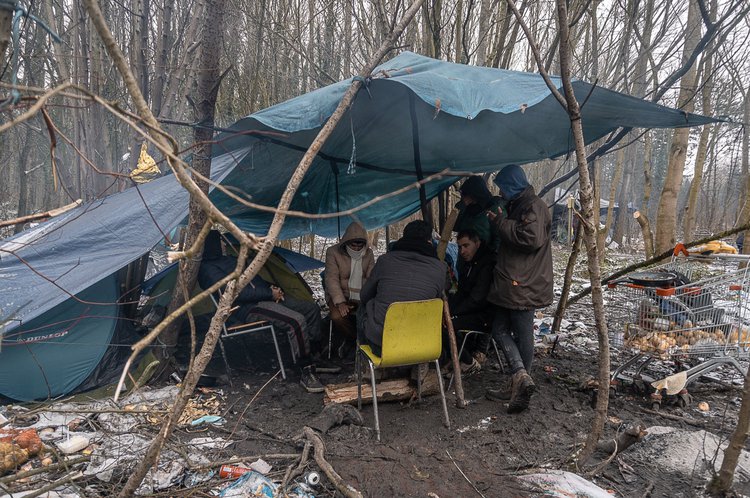
Footnotes
-
There are numerous publications on this, mostly in French and English. The most comprehensive overview is in: Michel Agier et al: La Jungle de Calais, Les migrants, la frontière et le camp, Paris, PUF, 2018 (Engl.: The Jungle, Calais’ camps and migrants, Cambridge, Polity, 2019; Engl.: Der “Dschungel von Calais”, Über das Leben in einem Flüchtlingslager, Bielefeld, Transcript, 2020). An indispensable electronic source for the period from 2015 onwards is the blog https://passeursdhospitalites.wordpress.com/.
↩ -
The deaths are systematically documented by the GISTI group, which presented a study in autumn 2020: https://irr.org.uk/wp-content/uploads/2020/11/Deadly-Crossings-Final.pdf. 296 deaths are listed in it. After publication, two more deaths became known in 2020. In addition, an already badly decomposed body was found in the port of Calais in early 2021. As it is highly likely to be a migrant, this was included as a further death for the period up to 2020. A dark field can be assumed.
↩ -
In addition to the aforementioned book by Michel Agier, see also: Samuel Lequette / Delphine Le Vergos (eds. ): Décamper, De Lampedusa à Calais, un livre de textes et d’images & un disque pour parler d’une terre sans accueil, Paris, La Découverte, 2016; Marie Godin et al: Voices from the Jungle, Stories from the Calais refugee camp, London, Pluto Press, 2017; Thomas Müller / Uwe Schlüper: Dynamics of the Jungles, Calais and the Euro-British Border Regime, Munich: bordermonitoring, 2018; Dan Hicks / Sarah Mallet: La Lande, The Calais ‘Jungle’ and Beyond, Bristol, Bristol University Press, 2019. On solidarity politics in the Athens-Calais comparison, see also Natasha King: No borders, The politics of immigration control and resistance, London, Zed Books, 2016.
↩ -
Cf. Agier et al, op. cit., pp. 129-133, 195-199; See also Thomas Müller u. Sascha Zinflou: Die Urbanität des Jungle, Calais und die Möglichkeit einer migrantischen Stadt, in; movements 2/2018, pp. 129-160.
↩ -
https://refugee-rights.eu/reports/the-long-wait and https://refugee-rights.eu/wp-content/uploads/2018/08/RRE_UnsafeBorderlands.pdf. See also the following studies https://refugee-rights.eu/wp-content/uploads/2018/08/RRE_StillWaiting.pdf; https://refugee-rights.eu/wp-content/uploads/2018/08/RRE_StillHere.pdf; https://refugee-rights.eu/wp-content/uploads/2018/08/RRE_TwelveMonthsOn.pdf.
↩ -
Cf. a. o.: https://helprefugees.org/wp-content/uploads/2018/08/Police-Harrassment-of-Volunteers-in-Calais-1.pdf; http://www.laubergedesmigrants.fr/wp-content/uploads/2019/06/Les-Expulsions-de-Terrain-a-Calais-et-aĚ-Grande-Synthe-FR-2.pdf; http://www.laubergedesmigrants.fr/wp-content/uploads/2020/07/HRO-eng-rep2019.pdf.
↩ -
Cf. a. o. the reports of Human Rights Watch (https://www.hrw.org/report/2017/07/26/living-hell/police-abuses-against-child-and-adult-migrants-calais) and Amnesty International (https://www.amnesty.org/download/Documents/EUR2103562019ENGLISH.PDF).
↩ -
Cf. https://www.defenseurdesdroits.fr/fr/rapports/2015/10/exiles-et-droits-fondamentaux-la-situation-sur-le-territoire-de-calais; https://juridique.defenseurdesdroits.fr/index.php?lvl=notice_display&id=18378&opac_view=-1; https://www.defenseurdesdroits.fr/fr/rapports/2018/12/exiles-et-droits-fondamentaux-trois-ans-apres-le-rapport-calais; https://defenseurdesdroits.fr/sites/default/files/atoms/files/cp_ddd_24-09-2020-visite-calais-clairehedon_0.pdf
↩ -
Cf. Corporate Watch: The UK Border Regime, A critical guide, London, Freedom Press, 2018, S. 23ff.
↩ -
The Human Rights Observers continuously monitor the situation according to a set scheme. Short reports on the individual (also smaller) evictions are published via Twitter, and the group also regularly submits monthly and annual reports: http://www.laubergedesmigrants.fr/fr/publications-hro/?fbclid=IwAR3o-RoH2sAFKZ1A1JuiGt8IcHCP9VlU79nxaz_uEqrTPQEiovmXhbzG6h4.
↩ -
For the following, see the interview with activist Maya Konforti: https://calais.bordermonitoring.eu/2020/05/15/whats-happening-is-crazy-its-inhumane-it-doesnt-work-but-its-going-to-continue/, as well as the study: https://calais.bordermonitoring.eu/2020/10/11/analyse-zum-einfluss-der-pandemie-auf-die-lage-der-exilierten/ and the blog post: https://calais.bordermonitoring.eu/2020/11/14/zweite-welle-ein-lagebericht/.
↩ -
https://passeursdhospitalites.wordpress.com/2020/11/17/lettre-ouverte-redigee-par-la-communaute-erythreenne-le-16-novembre-a-calais/; https://calais.bordermonitoring.eu/2020/11/22/polizeiuebergriff-mit-schwerverletztem-und-offener-brief-der-eritreer_innen-in-calais/#more-1454.
↩ -
On the origins of the canal route, cf. Thomas Müller / Uwe Schlüper / Sascha Zinflou: Querung des Kanals, Calais, der Brexit und die Bootspassagen nach Großbritannien, Munich: bordermonitoring, 2019. On further developments, cf. Tobias Müller: Das Elend von Calais, Der Brexit und die Bootsflüchtlinge, in: Blätter für deutsche und internationale Politik 11/2020, https://www.blaetter.de/ausgabe/2020/november/das-elend-von-calais-der-brexit-und-die-bootsfluechtlinge. The figures cited below are taken from reporting by the BBC and The Guardian as well as the compilation of further official and media data by the – albeit right-wing – portal Migration Watch.
↩ -
In addition to the study by GISTI already mentioned (see footnote 2), also the interview conducted on this subject with Maël Galisson: https://calais.bordermonitoring.eu/2021/01/07/ich-halte-das-recht-auf-freizuegigkeit-fuer-die-beste-loesung/#more-1728, supplemented by: https://calaismigrantsolidarity.wordpress.com/2021/01/29/in-the-name-of-god-au-nom-de-dieu/.
↩ -
https://www.gov.uk/government/publications/uk-france-joint-statement-collaborating-on-illegal-migration/uk-france-joint-statement-next-phase-of-collaboration-on-tackling-illegal-migration-28-november-2020; https://www.gov.uk/government/news/uk-and-france-sign-new-agreement-to-tackle-illegal-migration.
↩ - ↩
-
https://corporatewatch.org/cast-away-the-uks-rushed-charter-flights-to-deport-channel-crossers/ and supplementary: https://corporatewatch.org/hi-fly/.
↩